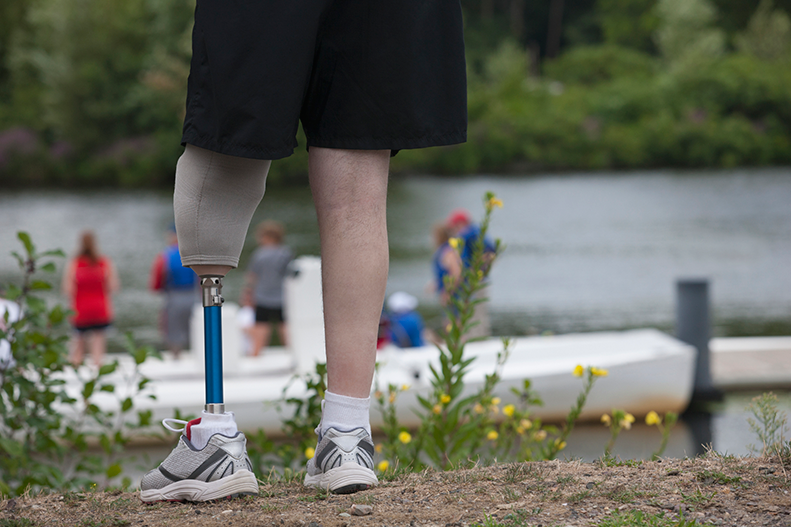The average inpatient stay following an amputation is typically about one week. However, the entire rehabilitation and recovery process varies for each patient and can take much longer.
During inpatient rehab, patients and their families have access to a fully staffed team of experts, including doctors, nurses, and physical and occupational therapists. Transitioning from inpatient rehab to life at home can be a challenging task for the patient and their family. The UPMC Rehabilitation Institute has a number of services available to ease in that transition.
“We assess patients usually before surgery, or soon after surgery while they’re recovering in the surgical ward,” says Michael Munin, MD, medical director of UPMC Rehabilitation Institute at Montefiore. “We address things such as hip or knee contracture, or tightness, and ways to prevent that. We discuss the health of the leg, pain management. Our ultimate goal here is trying to restore pre-amputation function, or at least get them to the highest level of function possible.”
The first step after inpatient rehabilitation is beginning outpatient rehabilitation. Outpatient rehab is similar to the care received during your stay; however, it can be done at a number of locations throughout Pittsburgh. The physical therapists at these locations will develop a care plan individualized to the needs of the patient. In addition to weekly appointments, patients are often given at-home exercises to supplement sessions with the physical therapist. Adhering to these plans is essential in the recovery process.
Never Miss a Beat!
Subscribe to Our HealthBeat Newsletter!
Thank you for subscribing!
You can now select the specific newsletters you'd like to receive.
You are already subscribed.
Subscribe to more newsletters in our email preference center.
Sorry, an error occurred. Please try again later.
Get Healthy Tips Sent to Your Phone!
In addition to working with a physical therapist, an occupational therapist can assist in acclimating to daily life. These specially trained therapists also can help patients regain their independence by learning to become safer and more efficient in everyday tasks.
“For lower limb amputation rehabilitation, we first get them to put weight on their prosthetic limb, then we start to build strength along the hip and knee joints as appropriate and work on range of motion,” says Dr. Munin. “At that point, we try to normalize the walking pattern to get it as normal as possible without deviation or limps. For the successful patient, they can actually walk down the street, for example, with long pants and no one would even know they are wearing a prosthesis.”
In addition to working with a physical therapist, an occupational therapist can assist in acclimating to daily life. These specially trained therapists also can help patients regain their independence by learning to become safer and more efficient in everyday tasks.
For many, a key to recovery — in addition to physical and occupational therapy – is participation in support groups. Amp Up! is a monthly meeting for amputees that offers support and information outside of the hospital setting. In addition to Amp Up!, the Amputee Coalition of America and National Limb Loss Information Center (NLLIC) can be valuable resources.
The expert team that patients have during their inpatient stay continues to monitor and supervise every step of the recovery process. In addition to overseeing patients’ recoveries, the doctors and support staff can:
- Help manage post amputation pain
- Perform gait evaluations
- Develop protocols to correct abnormal walking patterns with the prosthesis
More information on the UPMC Rehabilitation Institute and amputations can be found online at the UPMC Rehabilitation Institute website or by calling 1-877-AT-REHAB (28-73422).
Related Articles
- Inpatient Rehab Technology
Editor's Note: This article was originally published on , and was last reviewed on .
About Physical Medicine and Rehabilitation
At UPMC, we strive to improve your function after injury or illness. We help people recover from functional, pain-related, and neurological conditions, with both inpatient and outpatient care available. We are dedicated to providing you with exceptional clinical care and focused on developing new technologies and treatments to help you achieve mobility and maintain independence. Find a provider near you.

